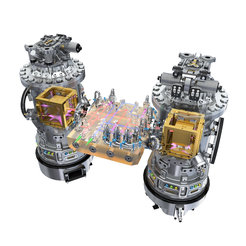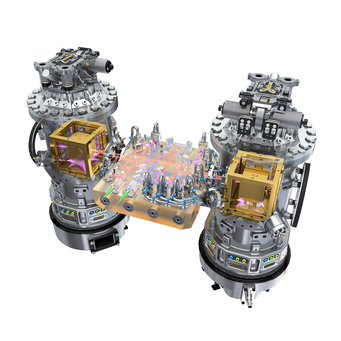LISA Pathfinder test masses floating freely
Major milestone towards science operations in March
The LISA Pathfinder mission scientists have successfully released both of the cubic gold–platinum test masses inside the satellite. LISA Pathfinder will place these cubes in the most precise free fall ever obtained to demonstrate technologies for observing gravitational waves from space.
LISA Pathfinder was launched on December 3, 2015 and reached its operational orbit – about 1.5 million kilometers from Earth towards the Sun – on January 22, 2016. The first science payload components were switched on successfully between January 11 and 13 and further commissioning has been ongoing since then.
Now, a major milestone towards full scientific operations (scheduled to begin on March 1) has been achieved. For the first time, LISA Pathfinder's test masses – two identical 46 mm gold-platinum cubes – have been released from their holding mechanisms and are floating freely inside the satellite.
“LISA Pathfinder continues to work perfectly! Releasing the test masses required some learning, but the team quickly found a smooth solution. The successful operation of a laser interferometer in space with two free falling test masses is a world first!” says Prof. Karsten Danzmann, director at the Max Planck Institute for Gravitational Physics and director of the Institute for Gravitational Physics of Leibniz Universität Hannover. “We are now very close to beginning our science mission, which will demonstrate the key technologies for the observation of gravitational waves from space.”
Throughout LISA Pathfinder’s ground handling, launch, the burns that raised its orbit, and the six-week cruise to its work site, each cube was held firmly in place by eight ‘fingers’ pressing on its corners. On February 3, the locking fingers were retracted and a valve was opened to allow any residual gas molecules around the cubes to vent to space.
Each cube remained in the centre of its housing held by a pair of rods softly pushing on two opposite sides. These rods were finally released from one test mass yesterday and from the other today, leaving the cubes floating freely several millimeters from the housing walls, with no mechanical contact with the spacecraft.

Precise measurements with laser interferometry
Between the two test masses, which are separated by about 38 centimeters, is a laser interferometer which will measure the test masses' positions and orientations relative to one another and to the satellite with unprecedented precision of roughly 10 picometers (one hundred millionth of a millimetre). The construction of the precise optical measurement system was led by scientists of the Max Planck and Leibniz Universität researchers in Hannover.
Currently, the test masses are controlled by electrostatic forces applied by the electrode housings, used to make the test masses follow the spacecraft. One week from today, with LISA Pathfinder running in science mode for the first time ever, the test masses will be released into full free fall and the spacecraft will start to follow their motions using its micro-Newton thrusters.
Data analysis in Hannover
After one week of final tests, on March 1, the LISA Pathfinder science mission will begin. It will demonstrate and validate key technologies for the detection of gravitational waves from space to pave the way for future gravitational-wave observatories in space such as eLISA.
Max Planck and Leibniz Universität researchers in Hannover are leading partners in the development of the data analysis software which plays a central role in extracting the crucial information from the science data, obtained after March 1. For this purpose the institute has set up an operations control room in Hannover. Since an immediate data analysis is required for the configuration of follow-up experiments, scientist from the institute will also take part in the around-the-clock shifts in the European Space Operations Centre (ESOC) in Darmstadt, Germany.
Funding information
LPF is an ESA mission, with the European space industry under the overall integration responsibility of Airbus DS and research institutions from France, Germany, Italy, the Netherlands, Spain, Switzerland and Great Britain as well as NASA participating.
LPF is funded through the German Aerospace Center (Deutsches Zentrum für Luft- und Raumfahrt; DLR) by the Federal Ministry for Economic Affairs and Energy based on a resolution of the German Bundestag.












